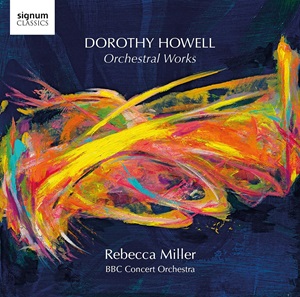
Dorothy Howell (1898-1982)
Orchestral Works
Humoresque (1919)
The Rock (1928)
Three Divertissements (1950)
Lamia (1919)
Koong Shee (1921)
BBC Concert Orchestra/Rebecca Miller
rec. 2022, St Jude’s Church, Hampstead, London
Signum Classics SIGCD763 [73]
Recent recordings of Dorothy Howell’s Lamia have brought her name to a wider public. This latest disc also gives us Lamia and adds three previously unrecorded works that Howell’s family brought to the attention of conductor Rebecca Miller, whose Howell Study Day was a valuable and visible display of Howell’s music.
Henry Wood was an admirer of Howell and it’s commonplace to quote his words on the success of Lamia’s premiere, which led to the work’s repetition no fewer than five times that season; ‘This was indeed exceptional for a British composer’s work – for a woman a triumph.’ Less often quoted is his pen portrait sketch of her as a pianist and pupil of McEwen at the Royal Academy and his promotion of her Piano Concerto and ballet music. ‘She was a fastidious composer, slow in production; consequently, she has produced few works; but they are all of distinction, for her themes and orchestration show real thought and musical feeling.’ This can all be put to the test here.
Miller has already conducted the Piano Concerto for Hyperion with Danny Driver (review). Her recording of Lamia takes its place alongside that of Rumon Gamba and the BBC Philharmonic, whose Chandos disc was the second volume in a series of British tone poems (review). Marius Stravinsky has also recorded it, adding the Piano Concerto, ex-Cameo recordings which can now be found in a Lyrita box (review), valuable in its time, though both other recordings far outstrip it in execution and recording quality. Her orchestral workmanship is at its most agile in this tone poem. Her use of the oboe as a succulent love focus, the surges of orchestral colour, the employment of solo strings too which Miller ensures meld with succeeding wind lines deftly. Ravelian in texture though it may be, for the first time I was momentarily aware of the influence of Dvořák on Howell – operatic Dvořák – as well as the overriding importance of Strauss. The seed for her future interest in ballet can also be felt. Miller takes the same tempi as Gamba.
Humoresque was composed in the same year as Lamia and is an orchestration of a piano original of no great length – four minutes in fact. Its light-hearted, jocular quality is underpinned by genial rhythms. The Rock of 1928 suggests, in name at least, something altogether craggier. It’s subtitled ‘Impressions of Gibraltar’ and was the result of a trip she’d made in 1924 and in the score she noted the many impressions she’d absorbed from braying donkeys to pan-pipes, embroidered shawls and the like. Now I’m as susceptible to braying donkeys as the next man, but I could have done with a bit more grit in this work. It has sultry rhythms – she seems here and elsewhere in her orchestral music to enjoy light, rather picture-postcard Spanish rhythms – and there are some lovely orchestral touches, such as the well pointed harp and the guitar-evoking pizzicati. There’s good bassoon writing as well. It remains songful and rather charming, though the themes aren’t in themselves quite memorable enough and contrasts aren’t sufficiently bold.
Koong Shee explored the vogue for chinoiserie in 1921. It’s her only ballet, but its first performance was given at the Proms in an unstaged performance. Once again, it’s the wind writing that impresses – sinuous and evocative – and mildly Sibelian. The harp is again deftly employed and the very clear recording allows one to hear every agent of her orchestration, whilst her string writing is often diaphanous and lightly Ravelian – I’ve cited Sibelius and Ravel for orientation purposes. Any chinoiserie is very lightly felt.
The Three Divertissements followed in 1950, her last large-scale orchestral work. The first of the three once again mines that element of Iberian sunshine that was clearly so much a feature of her music making, but the central panel strikes a darker note, a much more personal, pensive-sounding landscape, melancholy. Decidedly not the up-beat Howell one has become used to. Still, it’s back to the confident fast tempo of the final panel, with some Walton to be encountered in Imperial mode.
Rebecca Miller proves a sure hand directing the well-drilled BBC Concert Orchestra with flair and imagination. The recording, as noted above, is commendably detailed without being in any way anaemic and the documentation is fine too. That said, Lamia is certainly the best of Howell and nothing else stirs or intrigues the way it does.
Jonathan Woolf
Help us financially by purchasing from



















